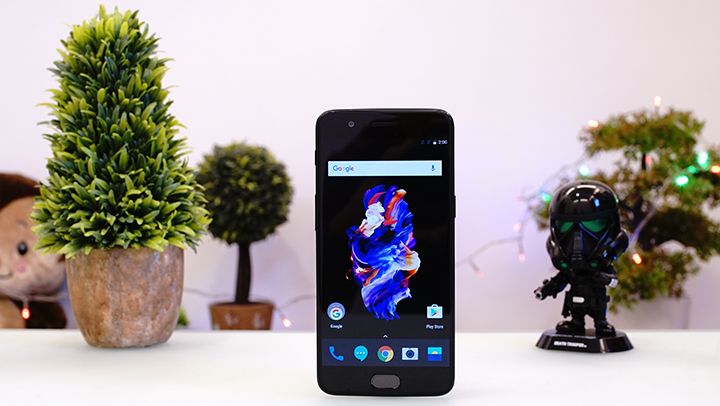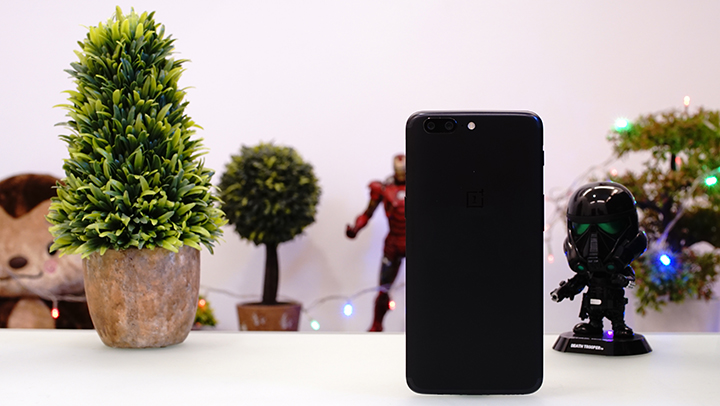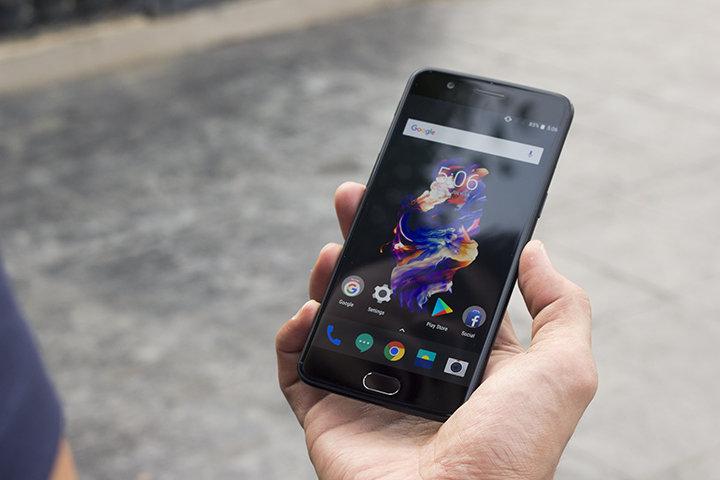Chinese company OnePlus has announced last month its latest flagship smartphone that sports high-end specs like the powerful Snapdragon 835 CPU, up to 8GB RAM, up to 128GB storage, and dual rear cameras. What we have on hand is the top of the line 8GB/128GB model. Will this prove to be worthy of being called 2017’s flagship killer? Join us in this full review of the OnePlus 5 and find out.
Table of Contents

The OnePlus 5 has the same 5.5-inch Optic AMOLED display as its predecessor — the now-discontinued OnePlus 3T. One of the main differences, though, is that the screen itself is now reinforced with a 2.5D Gorilla Glass 5 which is an upgrade from the previous model. It has that curved edge to add an overall premium feel to the device.

The front-facing camera is where it’s supposed to be and still features a 16-megapixel shooter. Other sensors, together with the loudspeaker for calls, populate this space.

Meanwhile, the fingerprint scanner is down below and is sandwiched between two capacitive buttons for Back and Recent Apps. It’s very responsive to the touch — sometimes a bit too responsive that it registers accidental touches as attempts to open the handset.

The handset has a unibody design and the rear has a matte finish. This is a very welcome approach since it doesn’t attract as much fingerprints and smudges as compared to having a glossy back. OnePlus was able to make the rear simple and neat by incorporating U-Type antenna bands up top and down below.

As more and more smartphones with dual rear cameras have now emerged, the company jumped right on the bandwagon with two sensors offering a 16-megapixel Sony shooter with a wide-angle lens and a 20-megapixel telephoto lens. These should work in tandem to offer its users flexibility while shooting. Accompanying them is a dual LED flash for low light photography.

Checking its underside, we have a busy setup going on since the audio jack, USB Type-C port, and speaker grille are all situated here leaving the top side totally free and clean.

There are two slots both for nano SIM cards on the right side of the device. There’s no third tray and it isn’t a hybrid setup meaning you won’t get to expand your storage anymore. But with 64GB and 128GB options, casual users should be fine.

On the flip side, we have the volume rocker together with what the company calls the ‘Alert Slider’. It is basically a mute toggle with 3 positions for activating between Silent, Do Not Disturb, or Ring functions.

At 153 grams, the device is on the light side with just the right amount of heft to make it sit comfortably in the palm of your hand. Although, its 7.25-millimeter thin body makes it easy to slip from your hand so it would be best to get a phone case if you’re worried about dropping or scratching the handset.
OnePlus used an Optic AMOLED display which is a technology not commonly heard of in smartphones. This is basically a tweaked out version of Samsung’s Super AMOLED panels with the company changing the saturation to show more natural, life-like colors in addition to having a bright display so light glares don’t impede the text or pictures when using the phone outdoors.

This is then fitted with a Full HD resolution with 1920 x 1080 pixels that equate to a 401ppi pixel density. Thanks to its tightly-packed display, details are what you’d expect from a top of the line device with clear images and legible characters. We’ve also mentioned that it’s reinforced with Gorilla Glass 5 so that should protect the screen from light scratches.

As for the sound it delivers, OnePlus has once again partnered with Dirac to bring high-quality audio to small speakers. With their technology, we would say that the handset produces decent sound quality when playing music or watching movies. Although, we were impressed since it can go loud to the point that we could still faintly hear it from another room, and with details, too.
Running it by our Audio Meter test, it was able to produce up to 77dB which is pretty loud for small speakers. Just like the OnePlus 3T, the single placement of its speakers makes it easy to accidentally cover the grilles when using the phone in landscape mode.
Running on an Android Nougat with the company’s Oxygen OS layered on top, the OnePlus 5 benefits from the updates this latest software brings. We also received a prompt to update it to Oxygen 4.5.5 so we did just that. As mentioned before, OnePlus’ own OS isn’t that different from stock Android with fewer bloatware apps and added customizations in theme and overall UX.

There’s also a feature called Shelf which basically replaces Google Now and it gives you access to your frequent apps and contacts. It can also be customized by adding widgets of different applications.

It’s also worth noting that the handset is equipped with a UFS 2.1 Dual Lane storage. The Universal Flash Storage comes after eMMC and is way faster when it comes to read and write speeds. Additionally, it runs on dual lane configuration meaning there are two lanes for data reading and another two lanes for data writing. This, as you would’ve guessed, makes things faster and more efficient for the device (about 26% better according to OnePlus).

Lastly, since we have the 128GB storage variant, you have about 111GB left when you boot the OnePlus 5 — leaving you with lots of space for your apps and media.
The OnePlus 5 sports the same 16-megapixel main shooter with a few twists. For one, it is now accompanied by a 20-megapixel telephoto lens similar to Apple’s iPhone 7. The new flagship also ditches Phase Detection Autofocus (PDAF) and Optical Image Stabilization (OIS) features present in OnePlus 3T for a new Fast Autofocus. According to the company, this is a lot faster than the performance of PDAF since it only uses half the pixels, unlike the Fast AF that utilizes the entire full pixel.

This is also the reason why the company says they no longer need OIS for photos. Electronic Image Stabilization (EIS), on the other hand, still aids in keeping your shots focused with minimal shakes. Based on our experience, focus time is indeed quick and we had no problems focusing on our subjects. Moreover, a dual LED flash helps illuminate your subjects during low-light instances.

Its Camera app has the usual Pro Mode for manual tweaking of its settings, Time Lapse, Slow Motion at 120fps (720p), Panorama, and Portrait just like with the iPhone 7 that digitally blurs the background to make the subject pop out more. This is a welcome addition, but I personally am never a fan of these software-treated bokeh shots as they’re not as natural-looking as I’d like them to be.

Bokeh effect on Portrait Mode
As for general shooting, we are greatly satisfied with the photos the OnePlus 5 churned out. Colors are vibrant while still looking natural, contrast is spot-on, and details are crisp. On the other hand, its 16-megapixel front-facing camera takes decent selfies but we wouldn’t say that it’s one of the handset’s strong suits. Details are there but suffer greatly when used in an area with little light.
Check out our sample shots on Auto Mode with the available aspect ratio (16:9/4:3):
HDR Comparison:
As mentioned, the secondary 20-megapixel rear shooter with F2.6 aperture is a telephoto sensor with 2x zoom. This is no digital magnification that loses quality the moment you zoom in. Its 2x zoom gets you closer to the subject without compromising quality.
Below are more samples:
Video recording maxes out at 4K resolution and maintains detail and color but shooting at night would result in some minor artifacts and digital noise to materialize.
Running the show is a Qualcomm Snapdragon 835 processor clocked at 2.45GHz partnered by an Adreno 540 GPU and a whopping 8GB of RAM. Having the latest chip from Qualcomm benefits the OnePlus 5 greatly as it is able to blaze through tasks without breaking a sweat. While also impressive for multi-tasking and other processes, we think the 8GB RAM is a bit of an overkill, more so for casual users. Still, it doesn’t hurt (maybe just budget-wise?) having that much memory at your disposal.

We ran our standard benchmark tests and the OnePlus 5 got commendable scores for comparison against other flagships.
Playing games like Asphalt 8 and NBA 2K17 proved to be an immersive and enjoyable experience since we didn’t come across any lags or app crashes. There were some dropped frames every once in a while but nothing too serious to distract you from enjoying. We did notice that the device gets warm when playing games or watching videos for an extended period of time, but again, nothing too alarming.
Jumping over to connectivity, the OnePlus 5 is capable of accommodating two nano SIMs with no slot for a microSD card to expand its built-in storage. What this means is that you just have to choose whether you’re going for the 64GB or 128GB variant and you’d have to stick with that storage space.

Left – Indoor | Right – Outdoor
There’s Wi-Fi with 2×2 MIMO, Bluetooth 5.0, NFC for wireless pairing, and GPS with GLONASS and BeiDou. You’d also be glad to know that it has LTE-A with support for Cat.12 for faster data connection. We ran GPS test and it was able to lock on to a good number of satellites both indoors and outdoors.
Using it to call is not a concern thanks to its loudspeaker that delivers clear audio. The person on the other line is also able to audibly hear our voice even while walking on a busy street thanks to the phone’s noise-cancelling microphones.
The OnePlus 5 carries a slightly smaller 3300mAh battery compared to the OnePlus 3T’s 3400mAh capacity. Don’t be fooled, though, as the company has added a number of power-saving features on the new flagship. For comparison, we both made the OnePlus 5 and OnePlus 3T go under the same PCMark battery test (Work 1.0) and the OnePlus 5 lasted much longer at 11 hours and 45 minutes compared to just 8.5 hours of the 3T.

We also subjected it to our video loop test on Airplane Mode with 50% brightness and volume and the handset was able to go for 18 hours and 12 minutes before we needed to charge it again. It also sports the company’s Dash Charge technology that fast charges the device. You’d be glad to know that in just 45 minutes, you’d be able to get 82% worth of battery life.
The OnePlus 5 ticks off a number of characteristics that we’re looking for in a smartphone. It has a thin and sexy body with a premium build, vibrant display, has a speaker that delivers loud audio, shoots detailed photos, runs UFS 2.1 for faster read and write speeds, has an impressive battery life, LTE with support for Cat. 12, and is a very capable performer thanks to its beefy internals.

Of course, there are things to watch out for like its glossy body that makes it slippery and the need for a case just to avoid scratching its surface. There’s also that large probability of the user accidentally covering the speaker grille when in landscape orientation. Finally, if we were to nitpick, its contact-sensitive fingerprint scanner might be a cause of annoyance in the long run.

With its local price tag, it could really claim the title ‘flagship killer’ as it could go toe-to-toe against other flagship smartphones with higher asking prices. The OnePlus 5 6GB + 64GB (Gray) is priced at Php27,300 while the 8GB + 128GB variant (Black) is at Php32,000 and is available at Widget City. See listing here.
OnePlus 5 specs:
5.5-inch Optic AMOLED display @ 1920 x 1080 pixels, 401ppi
2.5D Corning Gorilla Glass 5
2.45GHz Qualcomm Snapdragon 835 octa-core CPU
Adreno 540 GPU
6GB / 8GB RAM LPDDR4X
64GB / 128GB UFS 2.1 Dual Lane storage
16MP f/1.7 Sony IMX398 + 20MP f/2.6 2x telephoto rear cameras w/ dual LED flash
16MP front-facing camera
Dual-SIM (Nano)
LTE-A Cat12
Wi-Fi 802.11ac, 2×2 MIMO
Bluetooth 5.0
NFC
GPS, GLONASS, BeiDou
USB Type-C (USB 2.0)
Fingerprint sensor
Dirac HD Sound
Dirac Power Sound
3300mAh battery w/ Dash Charge (5V 4A)
Oxygen OS based on Android Nougat
152.7 x 74.7 x 7.25 mm
153 g
Midnight Black, Slate Gray
What we liked about it:
What we didn’t like:

YugaTech.com is the largest and longest-running technology site in the Philippines. Originally established in October 2002, the site was transformed into a full-fledged technology platform in 2005.
How to transfer, withdraw money from PayPal to GCash
Prices of Starlink satellite in the Philippines
Install Google GBox to Huawei smartphones
Pag-IBIG MP2 online application
How to check PhilHealth contributions online
How to find your SIM card serial number
Globe, PLDT, Converge, Sky: Unli fiber internet plans compared
10 biggest games in the Google Play Store
LTO periodic medical exam for 10-year licenses
Netflix codes to unlock hidden TV shows, movies
Apple, Asus, Cherry Mobile, Huawei, LG, Nokia, Oppo, Samsung, Sony, Vivo, Xiaomi, Lenovo, Infinix Mobile, Pocophone, Honor, iPhone, OnePlus, Tecno, Realme, HTC, Gionee, Kata, IQ00, Redmi, Razer, CloudFone, Motorola, Panasonic, TCL, Wiko
Best Android smartphones between PHP 20,000 - 25,000
Smartphones under PHP 10,000 in the Philippines
Smartphones under PHP 12K Philippines
Best smartphones for kids under PHP 7,000
Smartphones under PHP 15,000 in the Philippines
Best Android smartphones between PHP 15,000 - 20,000
Smartphones under PHP 20,000 in the Philippines
Most affordable 5G phones in the Philippines under PHP 20K
5G smartphones in the Philippines under PHP 16K
Smartphone pricelist Philippines 2024
Smartphone pricelist Philippines 2023
Smartphone pricelist Philippines 2022
Smartphone pricelist Philippines 2021
Smartphone pricelist Philippines 2020
Dondon says:
Did your unit have the jello screen effect reported by some unit owners?
Kevin Bruce Francisco says:
No, we tried scrolling to check the display but there was no jelly effect.
Uchiha says:
Gow do you know if you havejelly effect?
stormvoy says:
i just heard about this phone. seems funny to say “i have a oneplus 5”, which is six. they should have named it oneplus titan or oneplus amoeba or any non-numeric codename instead.
Carlos says:
Mr. Francisco
Do we have an official after sales support store/ address in-case the phone breaks? I would like to try to acquire one.